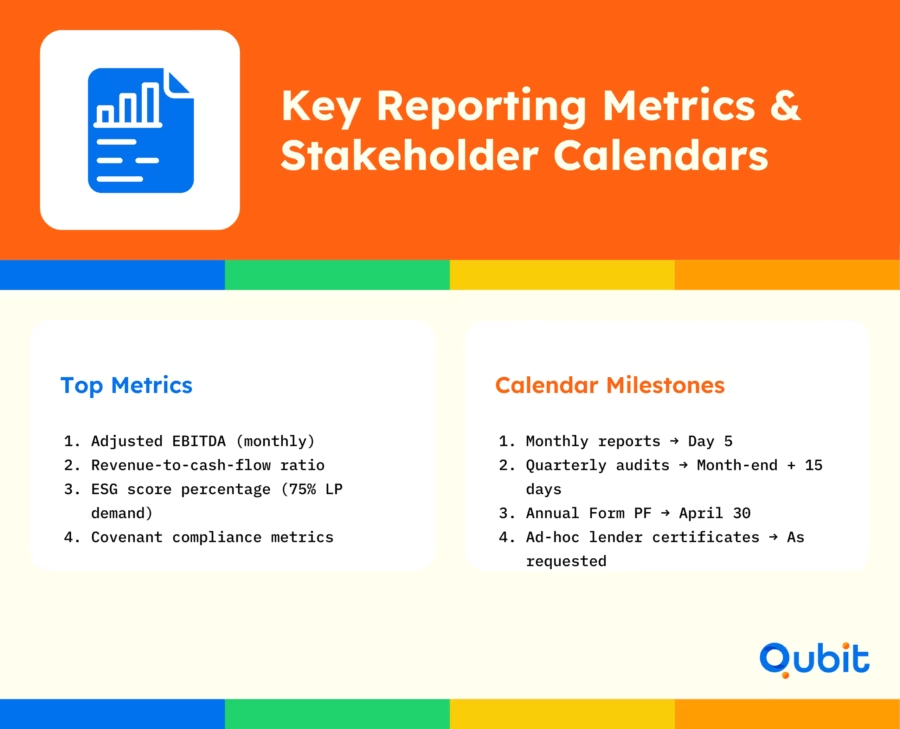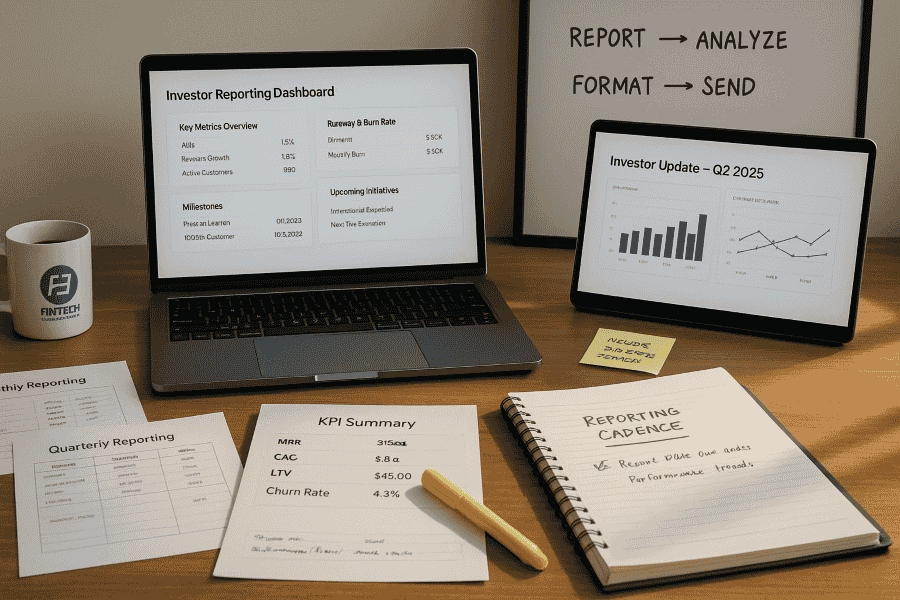Reporting private equity metrics requires a balance between compliance and actionable insights, enabling Limited Partners (LPs) to make informed decisions. For example, early-stage firms like Columbia, operating for just three years, have demonstrated how structured reporting can streamline investor relations.
Private equity funds often analyze revenue-to-cash-flow ratios, such as $100 million in revenue against $20 million in cash flow, to assess performance. Additionally, broader financial ecosystems, like those highlighted by the Alliance, showcase the importance of partnerships in enhancing reporting practices.
Investor outreach strategies offer a comprehensive framework that situates your reporting practices within a context of robust relationship building, seamlessly connecting overarching investor relations with specific communication details.
How to Improve Reporting with Fund Software and AI Insights
Advanced fund reporting software, combined with AI-driven predictive analytics, is transforming how firms approach this task. Let's look at some of the approaches which you can implement:
Focus on Cash-Generating Businesses
Prioritizing sustained cash generation over high-growth models can significantly enhance reporting accuracy. Businesses with consistent cash flow provide a stable foundation for predictive analytics, allowing fund managers to make more informed decisions. This approach ensures that reporting aligns with long-term financial goals rather than short-term fluctuations.
Prioritize CapEx-Intensive Investments
Investments in hardware and capital expenditure (CapEx)-intensive businesses demand detailed reporting due to their complex financial structures. Fund reporting software tailored to these operations simplifies the process, ensuring that every expenditure is accounted for. By focusing on CapEx-heavy portfolios, fund managers can deliver precise insights that resonate with stakeholders.
Reduce Reporting Latency with AI
AI-driven predictive reporting is revolutionizing fund management by reducing reporting latency by up to 50%. Integration of machine learning tools enables near real-time insights, especially for firms managing multiple portfolio companies. For example, AI can streamline cash flow forecasting, ensuring that fund managers have access to timely and accurate data.
To further enhance reporting strategies, fund managers can explore personalizing communication with investors, which explains how tailored messaging addresses individual stakeholder needs while supporting the broader themes outlined in your reporting strategy.
Breaking Down Private Equity Structures and Accounting Complexities
Private equity funds operate across diverse categories, each tailored to specific investment strategies. Here is a break down of PE structure and accounting complexities:
Fund categories
- Buyout funds: acquire controlling stakes in mature companies, then restructure operations to lift profitability.
- Growth-equity funds: provide capital to fast-growing businesses without taking full control, enabling scale-up.
- Venture-capital funds: back early-stage, high-potential startups—often tech or innovation driven.
Capital sources
Large institutions (pension funds, endowments, insurers) and high-net-worth individuals pour in most of the money, attracted by the prospect of outsized returns and portfolio diversification.
Industry scale
SEC Form PF filings peg private-equity assets at roughly $22.8 trillion, up 6.7 % year-over-year—evidence of the sector’s global weight and its demanding reporting environment.
Accounting and communication:
Intricate valuations, waterfall calculations, and multi-jurisdiction compliance require sophisticated fund-reporting systems that also help prevent common mistakes in investor communication by delivering clear, timely, data-driven updates to limited partners.
Make Financial Reports Work for All Your Stakeholders
Crafting financial reports that cater to diverse stakeholders is a balancing act requiring precision and clarity. Whether addressing investors, regulators, auditors, or management, the key lies in presenting consistent and actionable data. For private equity funds, this becomes even more critical as the volume of reporting grows.

One example is the staggering number of private funds—50,086—reported on Form PF in Q1 2024. This highlights the increasing regulatory demands placed on fund managers. To meet these expectations, reports must not only comply with regulations but also provide insights that resonate with each audience. For instance, benchmarking data helps investors evaluate fund performance, while lenders rely on compliance metrics to assess risk.
Private equity firms also face the challenge of delivering frequent and detailed comparisons, such as year-over-year (YoY), month-over-month (MoM), and year-to-date (YTD) analyses. These comparisons, paired with actual versus budget figures and reforecast analyses, ensure stakeholders remain informed and confident in decision-making.
To streamline communication, structured investor updates are essential. Resources like how to write investor updates present structured guidance that ties together narrative clarity with the practical elements of investor reporting, reflecting an integrated communication approach.
Align Reporting Calendars for Reliable Data Delivery
Effective reporting in private equity hinges on structured scheduling. Detailed corporate calendars play a pivotal role in transitioning from informal cash flow tracking to institutional reporting practices. Without a clear framework, under-invested finance and marketing departments often face scheduling conflicts, delaying critical investor updates and compliance reports.
A well-designed corporate calendar acts as a blueprint for streamlining cross-departmental coordination. It outlines key deadlines for monthly reports, quarterly reviews, audits, and budgeting cycles, ensuring all stakeholders remain aligned. For newly acquired portfolio companies, adopting a standardized calendar can significantly reduce inefficiencies. For example, using a corporate calendar template simplifies the integration process, enabling teams to focus on delivering accurate and timely data.
By addressing the challenges posed by under-investment and inconsistent scheduling, private equity firms can ensure reliable data delivery, fostering long-term success. Structured calendars are not just tools, they are essential for maintaining accountability and precision in fund reporting.
Focus on Key Metrics for Strong Private Equity Reporting
Effective reporting in private equity funds hinges on the ability to deliver timely, accurate, and comprehensive data. This process not only sustains investor confidence but also addresses the growing complexity of limited partner (LP) expectations.
Essential Metrics for Compliance and Transparency
Adjusted EBITDA remains a cornerstone metric for lender compliance, offering a clear view of operational performance while accounting for non-recurring expenses. Its inclusion in monthly reports ensures alignment with financial covenants and provides a reliable benchmark for stakeholders.
Beyond financial statements, private equity reporting often incorporates Key Performance Indicators (KPIs) and Management Discussion & Analysis (MD&A) segments. These elements provide deeper insights into portfolio performance, operational strategies, and future projections, fostering transparency and trust among investors.
The Role of ESG Data in Modern Reporting
Investor priorities are evolving, with 75% of LPs now demanding Environmental, Social, and Governance (ESG) metrics. Integrating ESG data into reporting not only meets these expectations but also positions private equity firms as forward-thinking and socially responsible. This shift highlights the importance of adapting reporting frameworks to remain competitive in a dynamic market.
Consequences of Reporting Delays
Delays in distributing accurate reports can have significant repercussions. For instance, the loss of three investors due to late or incomplete reporting underscores the critical need for punctuality. Such setbacks can erode trust and lead to long-term financial consequences.
Managing Expectations Through Consistent Reporting
Private equity firms that prioritize precision, timeliness, and adaptability in their reporting processes are better equipped to meet the demands of LPs and maintain robust investor relationships. Consistent reporting cycles and the inclusion of ESG data can recalibrate stakeholder and manage investor expectations.
Handle Lender Compliance and Reporting Challenges with Confidence
Meeting lender compliance requirements can be a daunting task, especially when dealing with borrowing base certificates and covenants. These documents demand precision and strict adherence to financial agreements, often requiring creative adjustments to metrics like EBITDA to align with lender expectations. For private equity fund accounting professionals, this process can be both time-consuming and complex.
Automation offers a transformative solution, cutting reporting preparation time by up to 35%, as demonstrated in a recent case study on SEC Form PF Amendments Implementation. By streamlining workflows, automation not only ensures accuracy but also frees up valuable resources for strategic decision-making.
Emerging trends, such as increased transparency in NAV financing disclosures, are reshaping reporting frameworks. With 37% of LPs now requiring weekly updates on net asset value calculations, fund managers must adapt to these heightened expectations. This shift underscores the importance of robust fund reporting software to meet evolving demands efficiently.
For firms seeking to stay ahead, embracing automation and innovative reporting tools is no longer optional—it’s essential. Addressing lender compliance challenges with confidence starts with adopting solutions that simplify processes while maintaining accuracy and transparency.
Tackle Reporting Challenges Using Proven Best Practices
A strong finance department is the backbone of effective investor reporting in private equity. Establishing clear communication channels through structured templates can significantly streamline reporting processes, ensuring accuracy and consistency. Templates not only reduce manual errors but also provide a standardized framework that simplifies complex private equity fund accounting tasks.
Transitioning to advanced systems like NetSuite can further enhance reporting capabilities. As an ERP system, NetSuite consolidates financial data and scales reporting to meet growing investor demands. For firms migrating from QuickBooks, this technology offers a seamless way to centralize operations and improve transparency.
Specialized reporting strategies can also drive measurable outcomes. For instance, integrating ESG metrics into LP reporting has proven transformative. A recent case study revealed that ESG-focused reporting contributed to a remarkable 22% increase in investments in female-led portfolios. This demonstrates how aligning reporting practices with investor priorities can foster trust and attract targeted investments.
Conclusion
Accurate and timely investor reporting is more than a compliance requirement; it’s a cornerstone for building trust and fostering transparency. Throughout this blog, we’ve explored integrated strategies and actionable frameworks that streamline reporting processes, ensuring clarity and precision. From adopting advanced technology to enhancing communication practices, these approaches not only simplify operations but also strengthen relationships with stakeholders.
If you’re ready to elevate your financial reporting, we can help. Explore our Financial Model Creation service to craft tailored solutions that meet your unique needs. Let’s work together to build a foundation of trust and success.
Key Takeaways
• Accurate, timely reporting builds investor trust.
• AI-driven tools cut reporting delays.
• Reporting calendars improve coordination and efficiency.
• Including ESG metrics meets LP expectations.
• Clear communication and strong financial processes prevent losses.
Frequently asked Questions
What should an investor report include?
An investor report should provide comprehensive financial statements, key performance indicators (KPIs), and a Management Discussion and Analysis (MD&A) section. Additionally, it should address specific investor concerns, include compliance data, and outline timetables for upcoming milestones.


 Back
Back



